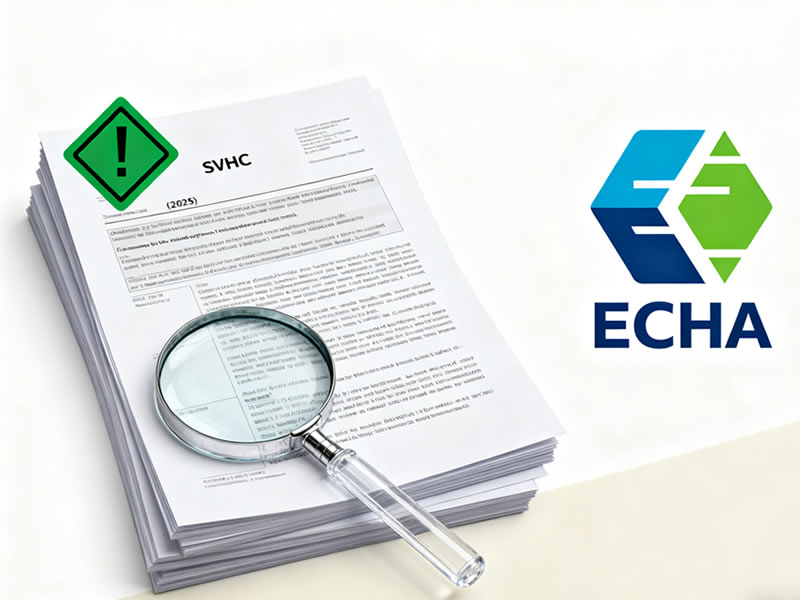I. Update Overview
On January 21, 2025, the European Chemicals Agency (ECHA) issued an announcement on the update of the Candidate List of Substances of Very High Concern (SVHC). This update adds 5 new substances and supplements the inclusion reasons for 1 existing substance on the list. After the update, the SVHC Candidate List contains a total of 247 substances.
II. Details of the 5 Newly Added SVHC Substances
The 5 newly added substances are included in the list due to their specific hazardous properties. The detailed information is shown in the table below:
| No. | Substance Name | EC Number | CAS Number | Reason for Inclusion | Example Uses |
|---|---|---|---|---|---|
| 1 | 6-[(C10 - C13)-alkyl (branched, unsaturated)-2,5-dioxopyrrolidin-1-yl]hexanoic acid | 701 - 118 - 1 | 2156592 - 54 - 8 | Reproductive toxicity (Article 57c) | Lubricants, greases, release products and metalworking fluids |
| 2 | O,O,O-Triphenyl phosphorothioate | 209 - 909 - 9 | 597 - 82 - 0 | Persistent, bioaccumulative and toxic (PBT, Article 57d) | Lubricants and greases |
| 3 | Octamethyltrisiloxane | 203 - 497 - 4 | 107 - 51 - 7 | Very persistent and very bioaccumulative (vPvB, Article 57e) | Used in the manufacture and/or formulation of cosmetics, personal care/health products, pharmaceuticals, washing and cleaning products, coatings and non-metallic surface treatments, as well as in sealants and adhesives |
| 4 | Perfluoramine | 206 - 420 - 2 | 338 - 83 - 0 | Very persistent and very bioaccumulative (vPvB, Article 57e) | Used in the manufacture of electrical, electronic and optical equipment, machinery and vehicles |
| 5 | Reaction mass of triphenyl phosphorothioate and tert-butylated phenyl derivatives | 421 - 820 - 9 | 192268 - 65 - 8 | Persistent, bioaccumulative and toxic (PBT, Article 57d) | No current valid registration |
III. Entry Update of Existing Substances on the List
ECHA has updated the entry of "Tris(4-nonylphenyl, branched and linear) phosphite" in the existing SVHC Candidate List, supplementing its environmental endocrine-disrupting properties. The specific update content is as follows:
| No. | Substance Name | EC Number | CAS Number | New Reason for Inclusion | Example Uses |
|---|---|---|---|---|---|
| 1 | Tris(4-nonylphenyl, branched and linear) phosphite | - | - | Endocrine-disrupting properties (Article 57(f) - environment) | Polymers, adhesives, sealants and coatings |
IV. Relevant Legal Obligations for Enterprises
Enterprises that use or are involved in SVHC substances must comply with the following legal obligations to ensure compliant operation:
1. Information Provision Obligation
Suppliers must provide sufficient information to customers and consumers to ensure the safe use of products containing SVHC substances with a concentration exceeding 0.1% (by weight of 4-nonylphenol, branched and linear (4-NP)).
2. ECHA Notification Obligation
If importers and manufacturers of products have articles containing SVHC substances with a concentration exceeding 0.1% (weight by weight, w/w), and the total annual amount of the substance exceeds 1 ton (per manufacturer or importer), they must submit a notification to ECHA within six months from the date the substance is included in the list.
3. Safety Data Sheet Provision Obligation
Suppliers of substances on the SVHC Candidate List, whether supplying the substance alone or in a mixture, must provide safety data sheets to their customers.
4. SCIP Notification Obligation
Pursuant to the Waste Framework Directive (Directive 2008/98/EC - WFD), since January 5, 2021, suppliers who place articles containing SVHC substances with a concentration exceeding 0.1% (weight by weight, w/w) on the EU market must submit a SCIP notification to ECHA for such articles. The SCIP database is established to store information on substances of concern in articles (either themselves or complex objects (products)), supplementing the existing notification obligations for SVHC Candidate List substances in articles under the REACH Regulation and the relevant information exchange requirements in the supply chain pursuant to Articles 7(2) and 33 respectively.

